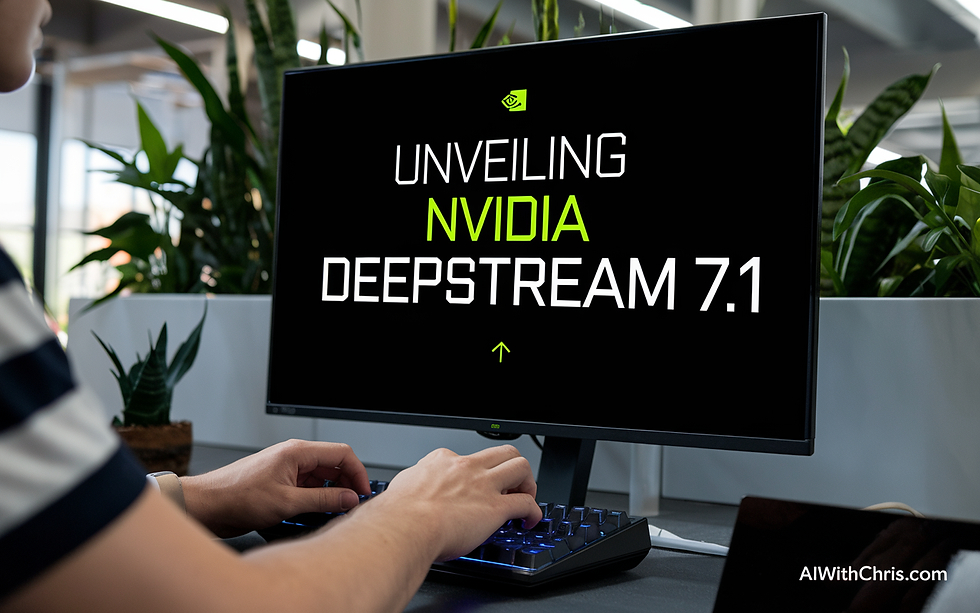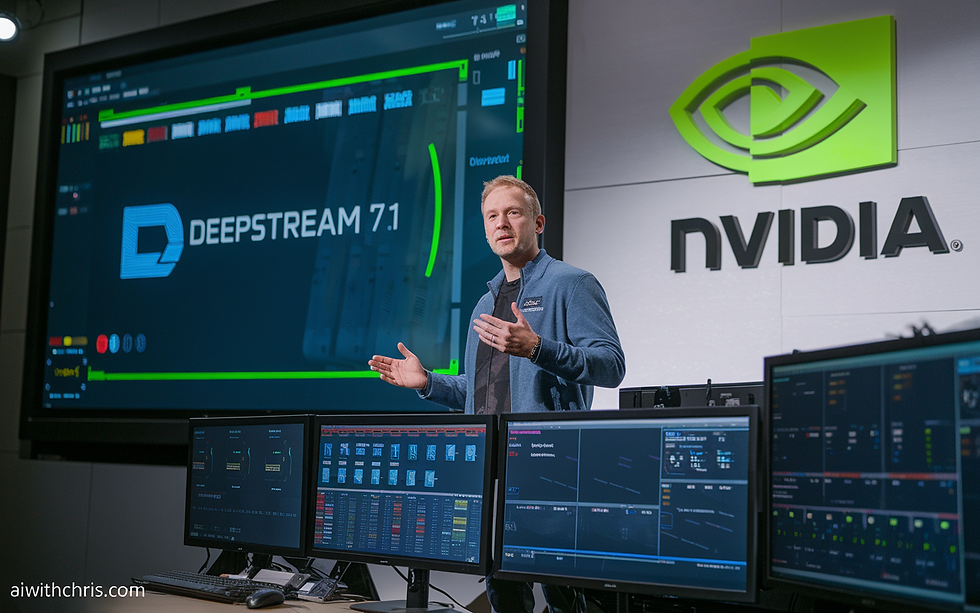Unveiling NVIDIA DeepStream 7.1: What's New and How It Transforms AI Vision Solutions
- AIwithChris

- Dec 2, 2024
- 3 min read

NVIDIA DeepStream 7.1: An Overview
NVIDIA has once again set the bar high with the release of DeepStream 7.1, its advanced Software Development Kit (SDK) that focuses on transforming streaming vision AI pipelines. This latest version brings forth remarkable upgrades that enhance the development process and optimize performance.
With a strong emphasis on hardware compatibility and performance improvements, DeepStream 7.1 positions itself to meet the growing demands of AI vision solutions across industries. Whether you are a developer looking to create cutting-edge applications or a business aiming to leverage AI's capabilities, the recent enhancements in this SDK are aimed at making the deployment process smoother and more efficient.
Key Features and Enhancements
One of the standout features in DeepStream 7.1 is its enhanced support for newer hardware. This release now accommodates NVIDIA's T4, Hopper, Ampere, and Ada Lovelace GPUs, significantly broadening the range of platforms on which developers can build their applications. Additionally, the support extends to NVIDIA Jetson Orin NX, AGX Orin, and Orin Nano systems, optimized for Ubuntu 22.04 LTS.
This robust hardware compatibility means developers can leverage the latest and most powerful GPUs for AI vision solutions, resulting in an overall performance boost. Improved efficiency not only enhances computation speed but also allows for more complex algorithms and models to be executed without compromising on latency or quality.

Integration with Triton Inference Server and Rivermax is another key highlight of this release. Triton 24.08 and Rivermax v1.40/v1.50 provide the necessary backbone for scalable deployment and efficient AI inference services. This allows developers to streamline their workflows and achieve faster inference on their models. With improved memory management and support for distributed execution available in Python APIs, working with large datasets and complex models becomes much more feasible.
The inclusion of a robust event-based scheduler as part of GXF 4.1 ensures optimal resource allocation and advanced thread management, thus enabling the creation of highly responsive applications that can dynamically adapt to changing workloads.
Transformative Development Features
Another remarkable addition to DeepStream 7.1 is the Python DeepStream Service Maker, a new application layer that greatly simplifies building vision AI applications using Python. This tool abstracts the technical complexities of the GStreamer application programming paradigm, allowing developers to focus more on functionality rather than intricacies of the underlying framework.
As a result, developers can produce applications faster and with less effort, potentially reducing the learning curve associated with the SDK. Moreover, enhanced tracking and re-identification capabilities have been integrated into this version, leading to improved accuracy in single-view 3D tracking, which is key for applications that require high-precision object tracking.
Support for new data types and formats, such as Gray 16 LE and UYVY (8-bit YCbCr-4:2:2) on x86 and dGPU platforms, provides developers with the flexibility to handle a wider variety of inputs. This particularly benefits industries like surveillance where different types of video format might be encountered.
The integration of models from the NVIDIA TAO Toolkit also opens the doors for a more diverse set of applications and solutions. This inclusion allows developers to easily access pre-trained models suited for specific tasks, enabling faster time to market and a more efficient development pipeline.

Enhancing User Experience with Additional Resources
To facilitate the transition and to maximize the potential of the DeepStream SDK, NVIDIA has rolled out comprehensive documentation and guides. Developers can take advantage of quick start guides and reference applications to expedite the learning process. Moreover, there are abundant webinars and technical blogs that dive into real-world applications of DeepStream.
Examples include insights into using DeepStream for retail analytics, patient monitoring, and even smart city infrastructure. These resources help developers understand how to implement their solutions effectively, debug issues, and innovate within their specific domains. The wealth of information available ensures that both new and seasoned developers can find valuable insights and support when embarking on their AI journey.
Conclusion
In conclusion, NVIDIA DeepStream 7.1 offers a robust toolkit for developers to elevate their vision AI solutions. With features aimed at improving performance, hardware compatibility, and user experience, this release is a substantial milestone in the evolution of streaming AI.
It empowers developers with the resources they need to create efficient, scalable applications that can cater to a diverse range of industries and needs. As AI technology continues to evolve, tools like DeepStream will undoubtedly play a crucial role in shaping the future of AI vision solutions.
Written by Chris Porter www.AIwithChris.com



Comentarios